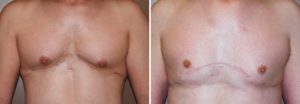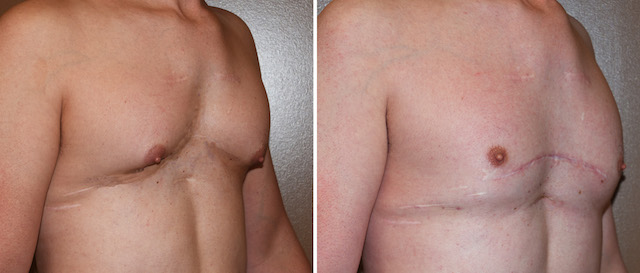Background: Pectus excavatum or funnel chest is a well known congenital chest wall condition where the sternum sinks into the chest. It usually appears right at birth and becomes more apparent as the patient grows. It is more common in males. Like all congenital conditions it presents with varying degrees of severity from minor sternal indentations to major sternal depressions with associated rib deformities and pulmonary restrictions.
Pectus excavatum surgery has been around for decades and originally was treated by radical resection of the attached ribs and direct sternal reshaping though an extended inframammary incision. This traditional surgery has largely been replaced by the insertion of rigid titanium bar under the sternum to lift it up. This creates less scar and exerts sustained pressure to push out the sternal depression.
One effect that is rarely talked about is the influence of almost any surgical intervention when done around developing structures that have a lot of growth to yet occur. While the operation may be successful in the short run, incisions and scar formation may yield secondary aesthetic issues due to growth disturbances that could not be predicted.
Case Study: This young male had a history of a Ravitch procedure for his pectus excavated deformity when he was around age five. As an adult he had a vertically constricted chest appearance like the lower half had not developed. In looking at where his ‘inframammary’ incision was located it was midway up on his chest. This would indicate to me that the pectorals major muscles had been either disinherited during the procedure or their growth was inhibited from the original pectus excavatm surgery. A custom sterno-pectoral implant was designed to fill in the sternal and lower chest wall defects.


Secondary sterno-pectoral deformities from a primary pectus excavated repair using a now historic technique can be improved by custom implant design and placement. The key is to make the implant smaller than what it appears is needed on the outside to account for the influence of the overlying soft tissues.
Case Highlights:
1) Traditional pectus excavated surgery when done very early in life, can result secondary chest wall deformities from stunted growth.
2) Re-expanding/re-creating the lower half of the chest wall (pectorlis major muscle) requires implant augmentation.
3) A custom sterno-pectoral implant is the most effective method of lower chest wall recontouring.
Dr. Barry Eppley
Indianapolis, Indiana






